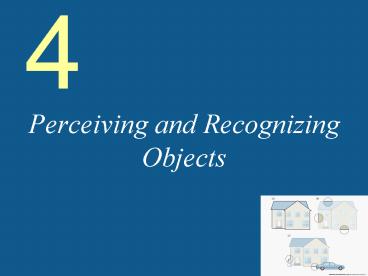Perceiving and Recognizing Objects - PowerPoint PPT Presentation
1 / 42
Title:
Perceiving and Recognizing Objects
Description:
Grouping and texture segmentation. Figure ground assignment. Edges, ... Subordinate level: sparrow/ostrich. Superordinate level: animals. 4. The Entry Level ... – PowerPoint PPT presentation
Number of Views:46
Avg rating:3.0/5.0
Title: Perceiving and Recognizing Objects
1
Perceiving and Recognizing Objects
2
Perceiving and Recognizing Objects
- Finding edges
- Grouping and texture segmentation
- Figureground assignment
- Edges, parts, and wholes
- Object recognition
- Objects in the brain
- Development of object perception
3
What Do You See?
4
Object Ambiguity
5
More Ambiguity Accidental Views
6
More Ambiguity Accidental Views (contd)
7
Every Image Is Ambiguous
8
Pandemonium
- Oliver Selfridge (1959)
- Simple model of letter recognition
- Demons loosely represent neurons each level
represents a different brain area - Perception by committee
- Pandemonium Model Online
9
Finding Edges
- Computer algorithms dont do a very good job
10
Finding Edges (contd)
11
Creating Edges
12
Rules for Linking Contours
- Good continuation group elements to form
smoothly continuing lines
13
Gestalt Psychology
- The whole is greater than the sum of its parts
- Wertheimer, Köhler, Koffka (1920s1950s) Palmer
and Rock (1990s) - Reaction to earlier structuralist school of
psychology
14
Texture Segmentation
- Linked to 2 Gestalt grouping principles
- 1. Group elements that are similar together
15
Texture Segmentation (contd)
- 2. Group elements that are proximal (close to
each other) together
16
Parallelism/Symmetry
- Somewhat weaker grouping principlesgroup
parallel and symmetric elements together
17
Dynamic Grouping Principles
- Common fate group elements moving in the same
direction together
18
Dynamic Grouping Principles (contd)
19
Dynamic Grouping Principles (contd)
- Synchrony group elements changing at the same
time together
20
Dynamic Grouping Principles (contd)
21
Modern Gestaltism
- Common region Elements perceived to be part of a
larger region group together - Connectedness Elements that are connected to
each other group together
22
FigureGround Segmentation
- What is the to-be-recognized object and what is
the background? - Gestalt figureground assignment principles
surroundedness, size, symmetry, parallelism
23
Meaning and FigureGround Assignment
- Is brown or white the figure here?
- Object recognition starts before figureground
assignment finishes
24
A Complicated Process...
- Which circles are figures and which are holes?
25
The Relatability Principle
- Q When should we complete edges behind
occluders? - A When the edges are relatable by an elbow
curve (Kellman and Shipley, 1991)
26
The Relatability Principle (contd)
27
Meaning in the Edges
- Non-accidental features provide clues to object
structure
28
Is the Whole Seen Before the Parts?
- Global superiority effect (Navon, 1977)
29
Parts and Wholes
- Pairs of concavities indicate part boundaries
(Hoffman and Richards, 1984) - What happens when cuts can go either way?
30
Parts and Wholes (contd)
31
High-Level Vision
- Processes in object recognition
- Determine features present in image (Low-level
vision) - Group features into objects (Middle vision)
- Match perceived to encoded representations
(High-level vision)
32
What Is a Representation?
- A thing that stands for another thing, for
example
33
Naive Template Theory
- Lock-and-key representations
- Problem You would need too many templates!
34
Structural Description Theory
- Represent the structure of an object, not what it
looks like from one view - Recognition-By-Components (RBC Biederman, 1987)
35
The Effect of Viewpoint
- RBC predicts viewpoint invariance
- Many empirical studies have found viewpoint
dependence - Viewpoint Effects Activity Online
36
Levels of Object Categorization
- What are these objects?
- Entry level birds
- Subordinate level sparrow/ostrich
- Superordinate level animals
37
The Entry Level
- Which label comes to mind first?
- The entry level term may be determined by a
perceptual committee
38
Face Recognition
- Whats wrong with this picture?
39
Face Recognition (contd)
40
Face Recognition (contd)
- Special processes may be involved in
identifying individual faces - Prosopagnosia Selective inability to recognize
faces
41
Objects in the Brain
- What system object identification (IT cortex)
- Where/how system object localization/
manipulation (parietal cortex)
42
Grandmother Cells
- Could a single neuron be responsible for
recognizing your grandmother?

